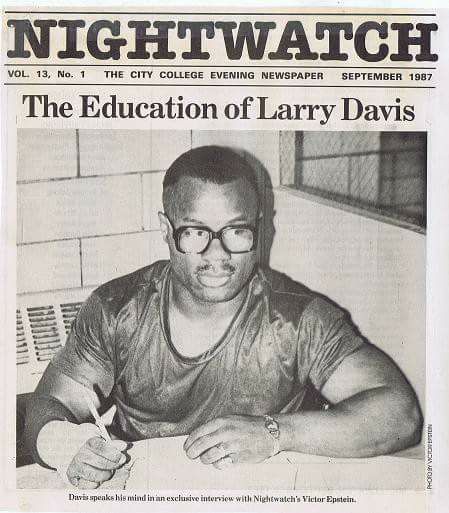Larry Davis (May 28, 1966 – February 20, 2008), who changed his name to Adam Abdul-Hakeem in 1989, was a New Yorker who shot six New York City Police Department officers on November 19, 1986 when they raided his sister’s apartment in the Bronx. The police said that the raid was executed in order to question Davis about the killing of four suspected drug dealers.
At trial, Davis’s defense attorneys, including William Kunstler, claimed that the raid was staged to murder him because of his knowledge of the involvement of corrupt police in the drug business. With the help of family contacts and friends, he eluded capture for the next 17 days despite a massive manhunt. Once the search was narrowed to a single building, he took several hostages but surrendered to police when the presence of reporters convinced him he would not be harmed.
Davis was acquitted of attempted murder charges in the police shootout case and also acquitted of murder charges in the case involving the slain drug dealers. He was found guilty of weapons possession in the shootout case, acquitted in another murder case, and was found guilty in a later murder case, for which he was sentenced to 25 years to life in prison. In 2008, Davis was stabbed to death in a fight with another inmate.
The Davis case generated controversy. Many were outraged by his actions and acquittal, but others regarded him as a folk hero for his ability to elude capture in the massive manhunt, or as the embodiment of a community’s frustration with the police, or as “a symbol of resistance” because “he fought back for African-Americans who are being killed by white police officers.”
Davis was the youngest of 15 children and a father to 1 daughter, Larrima Davis.Davis was sought as a suspect in seven murders: the execution-style killing of four drug dealers in a Bronx apartment, another during an apparent drug robbery in Manhattan, and two more. During the weeks before the raid, he knew he was wanted by the police and avoided his own apartment, spending time at his girlfriend’s and at his two sisters’ adjoining apartments on Fulton Avenue. At age 20, Davis had a record of arrests and convictions dating back over three years, to early 1983 and had violated his probation for a 1984 robbery.
Acting on a tip, in the evening of Wednesday, November 19, 1986 a team of 27 officers and detectives from the Bronx 41st Precinct and the NYPD’s elite Emergency Service Unit assembled in a parking lot. Wearing bulletproof vests and armed with shotguns and handguns, they went to the six-story Fulton Avenue building where two of Davis’s sisters had adjoining apartments on the ground floor. The police later said the raid was an attempt to question Davis. Although a “positive identification” of Davis had been made in a car chase 20 days earlier in which shots were fired at the police, he had not been named as a suspect in any crime, and no arrest warrant was issued until after the raid and shootout. A senior police official said that no charges had been brought beforehand because “once you move to introduce an accusatory instrument you lose the benefit of being able to talk to that person.” A lawyer for Davis said the raid was staged to kill him to suppress his knowledge of police involvement in drug sales.
At about 8:30 p.m. 15 officers surrounded the building and 12 others entered; nine of these went to the three-room apartment of Davis’s sister Regina Lewis and seven entered it. Davis, his girlfriend, his sister and her husband were in the apartment along with four children. Lewis’s two infant children were asleep in the bedroom at the rear.
According to an interview with Regina Lewis the next day, she answered a knock at the door and the police entered the living room with guns drawn. They told the adults to get the children out, and called out “Come out, Larry, you don’t have a chance – we’ve got you surrounded.” Thinking the police were about to start firing, Lewis shouted “Don’t shoot! My babies are back there!” At trial, accounts would differ as to whether Davis or the police fired first. The jury believed the events presented by the defense, in which an officer entered the apartment with a shotgun and fired at Davis, while he was seated behind a desk holding a baby. The officer, thinking he had hit Davis, was then shot in the neck by Davis with a handgun. The police took cover, returning fire as they retreated. In the confusion no one kept track of Davis, who slipped into his other sister’s apartment and escaped out a back window. Lewis had complained to her brother about him bringing guns to the apartment and told him to get out; he did leave but returned. She also quoted him as telling her, “If I’m caught in the street, the police are going to shoot me. But I am going to shoot them first.”
Police collected the shotgun and the expended shells from the .45-caliber pistol that Davis took with him. A .32-caliber revolver and .357 Magnum pistol were also left behind. Ballistics tests would later link the .32-caliber revolver to the Manhattan drug dealer killing and the .45 caliber pistol to the four dead Bronx dealers. A police official said that all escape routes had been covered by officers but none apparently saw Davis leave. He also said that the wounded officers were unable to return fire effectively due to the presence in the apartment of the two infants and other bystanders. Davis fired four shotgun rounds and nine .45 caliber pistol shots; the police fired four shotgun rounds and 20 pistol shots. Neither Davis nor the two infants with him in the bedroom were wounded.
In the following year, three of the wounded officers accused the NYPD of “negligent” and “reckless” planning and execution of the raid, and blamed the Bronx detectives for creating “chaos” by bursting into the apartment before Emergency Service Unit officers could seal off escape routes.
The six wounded officers were carried across the street to the Bronx-Lebanon Hospital and the manhunt began. The surrounding area and the rest of the building were searched immediately. Police stakeouts were set up at terminals, bridges and tunnels leading out of the city and a nationwide alarm was issued. As the manhunt spread, raids were staged in Chicago, Albany, Newark and other cities where Davis had relatives or friends. A man who said he was Davis called ABC-TV, expressing fears he would be beaten by police and stating he would not be taken alive.
Acting on a tip that Davis had been seen entering his mother’s home four days after the escape, police searched the building while interviewing Mary Davis in a laundromat across the street. She suffered an apparent heart attack shortly thereafter. As she recuperated three days later, she urged her son to call the NAACP, who had offered to help arrange a safe surrender.
On the afternoon of December 5, 1986, police received another tip that Davis had been seen entering the Bronx housing project where his sister Margaret lived. They surrounded the 14-story building, closed off local streets and posted sharpshooters on nearby rooftops. After searching his sister’s second-floor apartment, police began a systematic canvass of all 312 units. At some point during the day, Mr. Davis forced his way at gunpoint into Apartment 14-EB, where Elroy and Sophia Sewer lived with their two daughters, just as neighbor Theresa Ali, and her 2-year-old son, arrived for a visit. Mr. Sewer arrived home at 8 P.M. to find his family and the neighbors being held hostage by Mr. Davis. At 11:45 p.m. Davis released the two visitors and sent Mr. Sewer out to pick up food from a nearby Chinese restaurant. He also ordered Mr. Sewer to call Mr. Davis’ mother’s and sister’s tapped telephones and give false location information. When the husband returned with the food he was stopped for questioning by the police and, at 12:45 a.m., informed them that his wife and two daughters were being held hostage by Mr. Davis.
Police set up a command post in a nearby apartment and by 1:30 a.m. had established telephone contact. At one point Davis threatened to kill the hostages with a hand grenade, at other points he chatted with negotiators about stereo equipment, asked about a lawyer, and showed concern for his own safety, saying that he was afraid police would harm him. Throughout, negotiators repeated, “There is no use running, you have nowhere to hide now.” To assure Davis that he would not be harmed, police showed him the press credentials of three reporters in a nearby apartment and allowed him to speak to his girlfriend. At about 7 a.m. Larry Davis laid down his .45-caliber pistol and surrendered. As he was taken from the building in handcuffs, residents leaned out of their windows, clapped, and chanted Davis’s name.
Davis was serving his sentence at Shawangunk Correctional Facility near the Ulster County hamlet of Wallkill. At 7 p.m. on February 20, 2008, correctional officers overseeing one of the yards noticed inmates congregating around an apparent fight. When they went to break it up, they found Davis had been stabbed repeatedly with a 9 inches (23 cm) long metal shiv. He was taken by ambulance to St. Luke’s Hospital in nearby Newburgh, where he was pronounced dead on arrival.
After questioning by the state police and the New York State Department of Correctional Services’s (DOCS) inspector general’s office, another inmate, Luis Rosado, 42, was charged with murder.
Rosado was already serving a sentence of 25 years to life for murder and assault charges in the early 1980s, and had been denied parole in 2007. He was arraigned at Shawangunk Town Court the next morning. DOCS officials said both he and Davis had long disciplinary records, including fights with other inmates, but there was no record of any previous violence between the two.
On July 31, 2008, an Ulster County grand jury indicted Rosado on nine felony charges related to the stabbing, including three different counts of murder, assault, criminal possession of a weapon and possession of prison contraband. The murder charges carried a potential sentence of life without parole. After his arrest, Rosado was moved to Clinton Correctional Facility, located in upstate New York close to the Canadian border. On Wednesday, February 25, 2009, Luis Rosado pleaded guilty to first-degree manslaughter in Ulster County Court and was sentenced to an additional 10 years in prison, to be served consecutively with his current 25-to-life sentence for murder.

